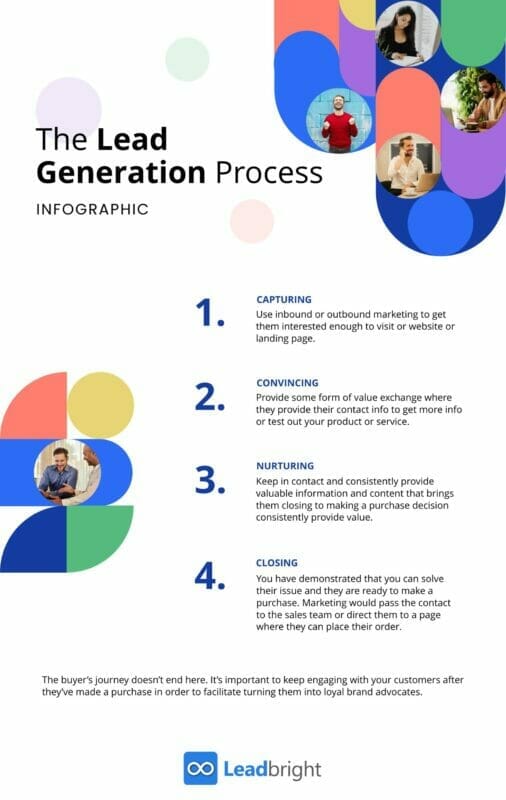Lead Generation: Everything a Beginner Needs to Know to Get Started

In the past, generating leads meant making cold calls and knocking on doors. While you might not want to entirely rule these strategies out, our increasingly digital world has opened up countless more opportunities for generating leads.
What is lead generation exactly, and why is it important for your business?
We’ll explore these and other questions below.
What Is a Lead?
Before we get too deep into things, let’s start with the basics. First, we’ll start by defining the term “lead.”
A lead is an individual who expresses interest in the product or service of a company. They might express this interest by sharing their contact information such as giving a phone number, email address, or social media handle.
What Is the Definition of Lead Generation?
Now that you know what a lead is, let’s take a look at the definition of lead generation. This refers to the process of identifying and cultivating prospective clients and customers. Through these methods, you are transforming someone who is a stranger to your company into someone who expresses interest in the services and products you offer.
Lead generation is a key element to growing your business. For example, a lot of companies will optimize their website for lead generation and use inbound marketing strategies to bring visitors in from organic searches.
What Is Lead Generation: Inbound Vs. Outbound
There are two main forms of lead generation, which are the inbound approach and the outbound approach.
The meaning of these terms is very much what they sound like. Inbound lead generation brings leads into you, while outbound lead generation goes out and finds the leads.
These two methods are similar in that they both have the same objective, which is to create demand or generate leads. Additionally, both of them require a good understanding of your target audiences.
Inbound Lead Generation
With inbound lead generation, you are encouraging individuals to express interest in your company with your website, content, social media, or blogs. This is an almost entirely digital approach.
Let’s take a look at some of the channels you can use to get visitors to become leads through inbound lead generation.
Content
A great way to bring your audience to a landing page’s content. Basically, you create content that is filled with useful information that users can access for free.
In the content, you can include calls to action (CTAs) in order to help direct them to your landing page where they can input their information. These CTAs can be anywhere in the content, at the bottom of the post, inline, or on the side panel.
Another great place to reach people who might already be aware of your product or service is email. This is a place where you can speak to people who have already subscribed to your list. It’s a good idea to use CTAs that have an eye-catching design and compelling copy to help grab their attention.
Ads and Retargeting
When you purchase ads, make sure that your landing page matches the offer that you promised in the advertisement. You also want to make sure that the action you’re asking users to take is perfectly clear.
Blog
Blogging is another great avenue for creating inbound leads. You can specifically design your blog posts to fit your end goal. This means that the CTA you include can be highly relevant and increases the likelihood that the reader will follow through to the landing page.
Referral Marketing
Referral marketing can also be referred to as word-of-mouth marketing. This is a type of marketing that got your brand in front of as many people as possible. What this does is that it increases your chance of generating more leads because more eyes have been in contact with your marketing.
Social Media
It is incredibly easy to guide your followers to take action using social media platforms. However, it is important to understand that each social media platform has its own demographic of users and style of marketing.
Product Trials
Offering trials to your product or service can help to break down a lot of the barriers in the way of a sale. It is much easier to entice a prospect with additional resources or offers once they have already started using your product or service.
It’s also a good idea to include branding in free versions of your product or service. This way, you can create an even wider net when it comes to capturing leads.
Outbound Lead Generation
On the other hand, an outbound lead generation is an approach that contacts potential leads through methods such as phone calls, emails, or events. By using impactful advertising and targeted outreach, outbound lead generation is a much more extroverted method of lead generation.
Let’s take a look at some of the types of outbound lead generation.
Cold Email
Cold emailing is when you contact a prospective lead who hasn’t shown interest in your company yet. While you might hear some people say that cold emailing is dead, this is far from the truth.
According to BtoB Magazine, nearly 60% of B2B marketers claim that their best channel for generating revenue is email. There are a number of companies that use cold email as their main marketing tool for acquiring new, high-quality leads.
(Interested in working with a fast-growing start-up that specializes in B2B lead generation? If so, learn more about Leadbright here!)
Cold Calls
In certain businesses and sectors, cold calling is still a very valid and relevant form of outbound lead generation. One of the most personable approaches you can take besides meeting potential leads face-to-face is calling them. However, it’s important to be sure to avoid coming off as a spammy telemarketer, as that is a surefire way for them to lose interest.
Some people actually find the personable approach of a phone call preferable these days. This is because everything is now online and so inhuman.
LinkedIn and Other Social Media
While you can use social media for inbound strategies, you can also use it for outbound strategies. LinkedIn is particularly good, though, for reaching out to potential leads in a productive way. If you do use LinkedIn in this way, be sure to personalize your messages and avoid them coming across as spam.
Online Communities
Not a lot of companies utilize this outbound lead generation strategy, but it can actually be a very successful method. Looking for online communities (meaning forums, subreddits, and Facebook groups) that are applicable to your product and service can be a great way to find high-quality leads.
It’s important if you go this route to always remember to provide value first. This means that you need to first join the community and observe it for a while. If you notice that someone posts a question about a problem that you have a possible solution to, you can offer valuable tips and advice without trying to sell them anything.
After you have spent some time building relationships in the community, it will become much easier to turn them into leads.
Job Boards
You might not think about job boards as a place to perform your outbound campaign. You can treat job postings that you make as outreach opportunities. This is particularly good for businesses that are service-based.
Networking Events
In-person is another potential strategy when it comes to outbound lead generation. While this might not be as easy in the days of the coronavirus pandemic, there will likely be opportunities in the future where you can attend networking events.
While this is not a way to scale your lead generation quickly, it is a great way to target highly qualified leads. Make sure that you are attending niche events that will certainly be attended by your ideal audience.
Cold Approaching
Cold approaching might seem very old-fashioned these days. However, in the right context, the strategy can still work wonders in today’s marketing world.
This is very similar to a cold call except that you are approaching someone in person. This is most effective for brands that work directly with consumers or with local brick-and-mortar businesses.
When you go this route, you can gain access to decision-makers instantly. By making an impression on them in person, there is a much higher likelihood that they will remember you and do business with you.
So, should we be knocking on more doors?
Not necessarily. It depends on your brand and the type of service or product you offer. That being said, it’s important to not simply discount a strategy just because it seems old-fashioned.
It’s important to remember that sometimes going against the crowd can be advantageous to your business. While people are being bombarded by online ads, they might find it refreshing and charming to be approached by an actual person. They will likely remember the encounter with greater clarity and it will make more of an impression on them if done right.
The Lead Generation Process
In its simplest form, the lead generation process can be dissected into four different steps. These are capturing, convincing, nurturing, and closing.
Capturing
The absolute first step of lead generation is capturing the attention of a stranger and persuading them to visit your website or landing page. You might do this through an engaging post on social media, a Facebook Ad, or through some other method.
Convincing
The next step is to convince this individual to provide their contact information to you. There are a number of ways you can do this. You might consider using a lead magnet, such as a valuable piece of content that they can access after they fill out a form that is found on the landing page.
Nurturing
Once they have filled out the form and offered their contact information, this person has officially become a lead. Now that they are a lead, it’s time to start nurturing them. You can do this through your marketing communication, which might consist of a mix of email, paid ads, webinars, and in-app notifications.
This nurturing stage helps to ensure that the individual will come to your brand when they’re ready to buy a product or service that you offer.
Closing
When a lead has reached the stage in the process where they’re ready to click “buy,” it’s time for you to either pass them on to your sales team or direct them to a page where they can place their order.
Even though you’ve closed the sale (congratulations!) the buyer’s journey doesn’t end here. It’s important to keep engaging with your customers after they’ve made a purchase in order to facilitate turning them into loyal brand advocates. This engagement can largely be done through marketing automation tools.

(Are you interested in the powers of automation? Learn more about the future of AI-powered website content automation here.)
How Content Marketing Can Help You Generate Leads
Did you know that you can generate three times as many leads when you use content marketing versus traditional marketing?
That being said, content marketing is more than just posting some half-hearted blogs every once in a while. Having a strategy that focuses on a buyer persona, specific goals, well-designed landing pages, and more can ensure that your content marketing campaigns result in as many high-quality leads as possible.
When you utilize the full power of content marketing it can help your business grow in both its reach and revenue.
How Does B2B Lead Generation Differ From B2C Lead Generation?
When you run a B2B brand, there are important differences in the way you will generate leads compared to B2C companies.
For one, you are typically seeking much larger contracts as a B2B company than a consumer-oriented brand. That means that you will have a longer sales cycle and a more elaborate campaign.
Your content will also have to focus on creating unique, knock-their-socks-off content to generate leads for a B2B company. This is because your customers are knowledgable about the industry and will require content like white papers, case studies, and infographics to help convince them to become a customer.
Also, the market you are appealing to is much narrower with B2B lead generation. You’re just marketing to the decision-makers of companies rather than the general public. This means that your approach should be more personalized and more proactive.
You’ll also find that LinkedIn is a much more useful social media platform for lead generation for B2B brands rather than more casual sites.
When you are lead hunting as a B2B company, your goal is to build a personal relationship with prospective customers. This is a relationship that is built on trust and respect.
Lead Generation: Grow Your Business By Generating More Leads
You’ve created an incredible product or service that helps people solve their problems. That’s only the first step in the process, though. Through lead generation, you can ensure that your target customers know about your brand and think of you when they are confronted with the problem your business can solve.
Is it time for you to start generating leads and growing your brand? Leadbright is a fast-growing startup that is the leader in online B2B lead generation and AI website content automation. If you’re ready to take your business to the next level, click here to start now!


